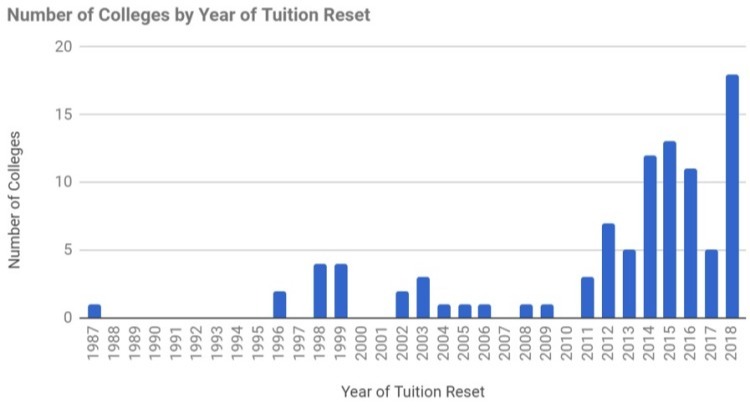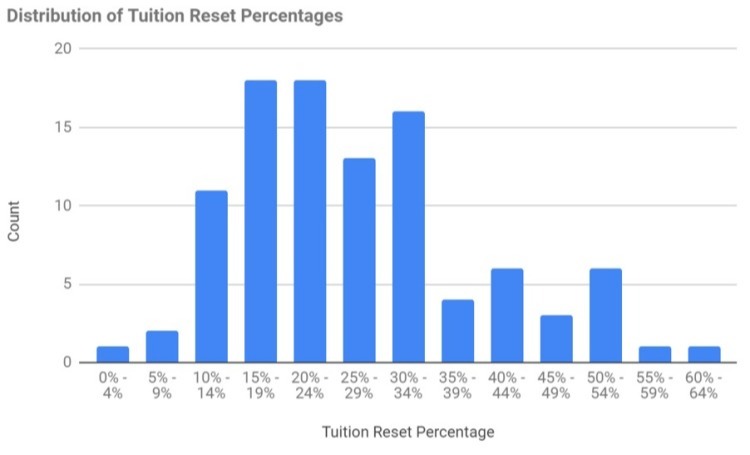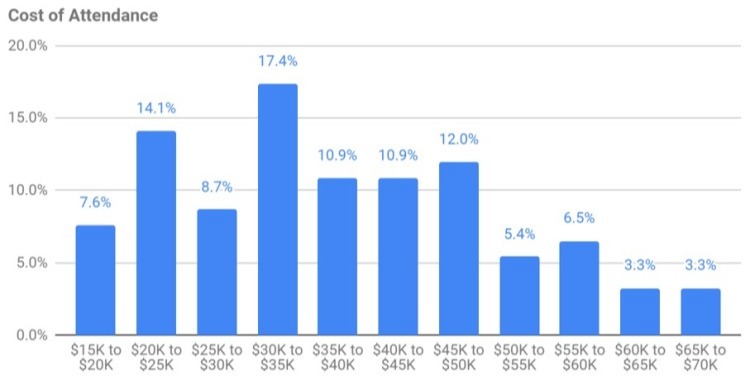The number of colleges pursuing tuition resets has surged in recent years. From 1987 through 2011, an average of one college a year cut tuition rates. From 2012 through 2018, the number of colleges cutting tuition increased tenfold to an average of 10 colleges per year, peaking at 18 in 2018.
A tuition reset is a one-time reduction in a college’s tuition rate, usually accompanied by a cut in financial aid. The college’s net price usually does not decrease by much. However, the unusual nature of a tuition cut, especially if it involves a large percentage or large dollar reduction, yields news media coverage that can attract more applicants for admission and a larger class size without compromising on quality. After the cut, the college’s tuition increases each year at typical rates.
Thus, the shift away from a high-cost/high-aid model can lead to an increase in enrollment that can improve a college’s finances.
Number of Colleges with Tuition Resets
A total of 91 colleges have implemented 95 tuition resets from 1987 to 2018, based on press releases and data from the Integrated Postsecondary Education Data System (IPEDS). Three colleges spread the tuition resets over two adjacent academic years, while one college followed a 30% tuition cut in 1999-2000 with a 25% cut 20 years later. An additional five colleges have implemented tuition cuts in 2019-2020 so far.
As illustrated in this chart, tuition cuts were relatively rare from 1987 to 2011, more of a curiosity than a trend, with an average of one per year. Starting in 2012, however, the number of colleges implementing tuition cuts has increased significantly, ranging from 5 to 18 a year, with an average of ten per year.

Magnitude of Tuition Resets
The percentage cut in tuition ranged from a minimum of 4% to a maximum of 61%, with an average cut of 26%. The typical cut ranges from 10% to 33%, as shown in this chart. More than two-thirds of the tuition resets ranged from 10% to 33%, with an additional quarter cutting tuition by more than a third.

Characteristics of Colleges that Implement Tuition Resets
More than 93% of the colleges were nonselective, accepting 40% or more of their applicants. More than four-fifths of the colleges have a yield of less than one third of admitted students. This makes it challenging for the colleges to increase tuition revenue by accepting more students, especially full-pay students.
The 25th percentile SAT scores are less than 1100 (below average) at 90% of the colleges. The 75th percentile SAT scores are less than 1300 at 91% of the colleges.
The colleges are small, with 77% having total enrollment under 5,000 students. More than a third have less than 1,000 students.
Almost all of the colleges award Bachelor’s degrees or more advanced degrees, with only 2% awarding only Associate’s degrees.
Three quarters of the colleges are private non-profit 4-year colleges (78%) and a fifth are public 4-year colleges (18%), with 2% private for-profit 4-year colleges, 1% private non-profit 2-year colleges and 1% community colleges.
Most of the colleges are tuition dependent, without big endowments.
Almost half of the colleges are located in cities (48%), 18% are suburban, 24% are located in towns and 10% are located in rural areas.
Most of the colleges recruit their students regionally, and are not well-known nationally.
High-Cost / High-Aid Model
The Chivas-Regal Effect occurs when increasing the price of a product or service increases demand for the product. In the context of college pricing, families assume that a college is better quality just because it costs more.
For example, a private non-profit college that charges $50,000 a year might offer full-pay students a $10,000 “merit” scholarship, discounting the net price to $40,000. These students prefer the private college over a less expensive $30,000 public college because the public college doesn’t award them a $10,000 scholarship.
But, the Chivas-Regal effect loses its luster when most colleges charge prices that are about as much as a small mortgage.
Some of these colleges discover that they are on the wrong side of the Laffer Curve. They can increase enrollment and total revenues by cutting tuition (and financial aid). The net price does not change by much, but the tuition reset attracts students who did not consider the college because of the high sticker price.
The colleges remain expensive after a tuition reset, just not as highly expensive as before.
All of the colleges that implemented a tuition reset now charge a cost of attendance of $15,000 or more, as shown in this table, compared with 59.5% of all public and private non-profit 4-year colleges, according to the College Board’s Trends in College Pricing. More than two-thirds of the colleges (70%) charge $30,000 or more. However, only 18.5% charge $50,000 or more.

Colleges that Implemented Tuition Cuts
This table lists the colleges that have implemented tuition cuts. Most of the cuts were unrestricted, with just a handful of the cuts limited to low-income students, specific programs, state residents or out-of-state and international students.
School |
Tuition Cut |
Year of Cut |
Waldorf University (IA) |
30% |
1987-1988 |
Muskingum College (OH) |
29% |
1996-1997 |
North Carolina Wesleyan College (NC) |
23% |
1996-1997 |
Bluefield College (VA) |
24% |
1998-1999 |
Pine Manor College (MA) |
34% |
1998-1999 |
Sheldon Jackson College (AK) |
42% |
1998-1999 |
Thiel College (PA) |
27% |
1998-1999 |
College of William & Mary (VA) |
20% |
1999-2000 |
Marlboro College (VT) |
8% |
1999-2000 |
University of Virginia (VA) |
20% |
1999-2000 |
Wells College (NY) |
30% |
1999-2000 |
Bethany College (WV) |
42% |
2002-2003 |
Heidelberg College (OH) |
28% |
2002-2003 |
Abilene Christian University (TX) |
50% |
2003-2004 |
College of Idaho (ID) |
30% |
2003-2004 |
Westminster College (MO) |
20% |
2003-2004 |
Eureka College (IL) |
30% |
2004-2005 |
North Park University (IL) |
30% |
2005-2006 |
South Dakota Colleges (SD) |
50% |
2006-2007 |
Blackburn College (IL) |
15% |
2008-2009 |
Penn Foster College (Online) |
28% |
2009-2010 |
Brewton-Parker College (GA) |
20% |
2011-2012 |
Davis College (NY) |
14% |
2011-2012 |
University of the South / Sewanee (TN) |
10% |
2011-2012 |
Burlington College (VT) |
25% |
2012 (Summer) |
Cabrini University (PA) |
13% |
2012-2013 |
Duquesne University (PA) |
50% |
2012-2013 |
Lincoln College (IL) |
24% |
2012-2013 |
Seton Hall University (NJ) |
61% |
2012-2013 |
University of Charleston (WV) |
22% |
2012-2013 |
William Peace University (NC) |
8% |
2012-2013 |
Harrison College (IN, OH, NC, online) |
10% |
2013 (Winter) |
Ancilla College (IN) |
4% |
2013-2014 |
Belmont Abbey College (NC) |
33% |
2013-2014 |
Concordia University (MN) |
34% |
2013-2014 |
Saint Louis Christian College (MO) |
48% |
2013-2014 |
Alaska Pacific University (AK) |
34% |
2014-2015 |
Ashland University (OH) |
34% |
2014-2015 |
Ave Maria University (FL) |
22% |
2014-2015 |
Converse College (SC) |
43% |
2014-2015 |
Lesley University (MA) |
25% |
2014-2015 |
National Louis University (IL) |
19% |
2014-2015 |
Ohio Northern University (OH) |
24% |
2014-2015 |
Pacific States University (CA) |
17% |
2014-2015 |
Piedmont International University (NC) |
25% |
2014-2015 |
Southern Virginia University (VA) |
23% |
2014-2015 |
St. Vincent’s College (CT) |
14% |
2014-2015 |
Wilson College (PA) |
17% |
2014-2015 |
Boston Baptist College (MA) |
15% |
2015-2016 |
College of Mount Saint Vincent (NY) |
28% |
2015-2016 |
Everest University (FL, MO) |
20% |
2015-2016 |
Lewis-Clark State College (ID) |
16% |
2015-2016 |
Lincoln Christian University (IL) |
20% |
2015-2016 |
National Louis University (IL) |
18% |
2015-2016 |
Paul Quinn College (TX) |
38% |
2015-2016 |
St. Vincent’s College (CT) |
12% |
2015-2016 |
Stephen F. Austin State University (TX) |
15% |
2015-2016 |
Stillman College (AL) |
34% |
2015-2016 |
University of North Texas (TX) |
46% |
2015-2016 |
Wilberforce University (OH) |
11% |
2015-2016 |
Wilmington College (OH) |
16% |
2015-2016 |
Central Washington University (WA) |
15% |
2016-2017 |
Eastern Washington University (WA) |
15% |
2016-2017 |
Evergreen State College (WA) |
15% |
2016-2017 |
Lewis-Clark State College (ID) |
15% |
2016-2017 |
Pima Community College (AZ) |
15% |
2016-2017 |
Rosemont College (PA) |
40% |
2016-2017 |
Rutgers University – Camden (NJ) |
50% |
2016-2017 |
University of Washington (WA) |
10% |
2016-2017 |
Utica College (NY) |
42% |
2016-2017 |
Washington State University (WA) |
10% |
2016-2017 |
Western Washington University (WA) |
15% |
2016-2017 |
College of Saint Mary (NE) |
33% |
2017-2018 |
Drew University (NJ) |
20% |
2017-2018 |
Immaculata University (PA) |
23% |
2017-2018 |
La Salle University (PA) |
29% |
2017-2018 |
University of Southern Mississippi (MS) |
40% |
2017-2018 |
Avila University (MO) |
33% |
2018-2019 |
Benedict College (SC) |
26% |
2018-2019 |
Birmingham Southern College (AL) |
51% |
2018-2019 |
Canisius College (NY) |
23% |
2018-2019 |
Central Michigan University (MI) |
47% |
2018-2019 |
Champlain College (VT) |
50% |
2018-2019 |
Cleveland Institute of Music (OH) |
15% |
2018-2019 |
College of St. Joseph (VT) |
24% |
2018-2019 |
Cornerstone University (MI) |
11% |
2018-2019 |
Glenville State College (WV) |
27% |
2018-2019 |
Indiana University of Pennsylvania (PA) |
20% |
2018-2019 |
Mills College (CA) |
36% |
2018-2019 |
Sweet Briar College (VA) |
32% |
2018-2019 |
The Master’s University (CA) |
26% |
2018-2019 |
University of Detroit Mercy (MI) |
32% |
2018-2019 |
University of Sioux Falls (SD) |
36% |
2018-2019 |
University of the Sciences (PA) |
37% |
2018-2019 |
Warner Pacific University (OR) |
24% |
2018-2019 |
University of the Cumberlands (KY) |
57% |
2019-2020 |
Stephens College (MO) |
27% |
2019-2020 |
St. John’s College (NM, MD) |
33% |
2019-2020 |
Wells College (NY) |
25% |
2019-2020 |
Oglethorpe University (GA) |
16% |
2019-2020 |
Only two of these colleges subsequently closed.
How Many Colleges Could Implement a Tuition Reset?
To estimate the number of colleges that could implement a tuition reset, consider the characteristics of colleges that previously implemented a tuition reset:
- At least 90% of undergraduate students receiving gift aid
- At least 90% of undergraduate students in each income quintile are receiving gift aid
- The average grant in each income quintile is at least 25% of tuition
- College accepts 40% or more of applicants (high acceptance rate)
- Less than 33% of accepted applicants enroll in the college (low yield)
- Tuition is $15,000 or more
- The average grant amount is $10,000 or more in all income quintiles
- The average grant amount is at least 25% of the cost of attendance
- The tuition, after the reset, will be less than $30,000 but at least $10,000
A total of 273 private non-profit 4-year colleges satisfy these criteria. To be sure, determining whether a tuition reset will be effective requires a deeper analysis, especially of the competitive environment. Also, a tuition reset might not be a good fit for the college’s strategic goals. But, more colleges are likely to implement tuition resets as they face enrollment and financial challenges.




